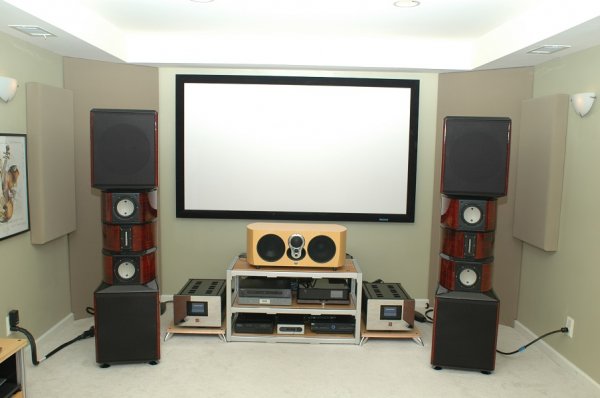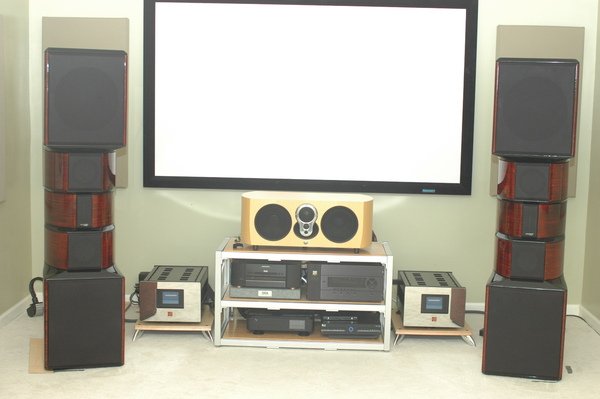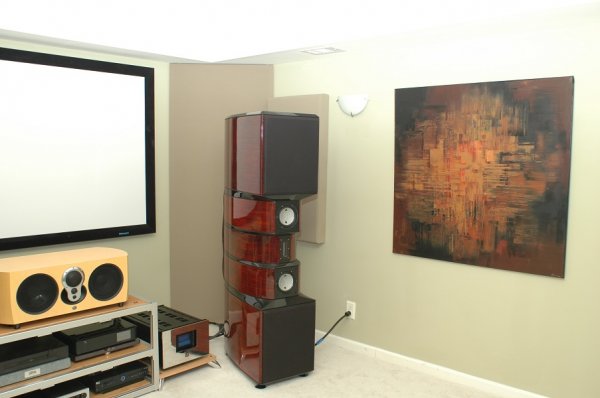Upgrade prioritization
- Thread starter edorr
- Start date
You are using an out of date browser. It may not display this or other websites correctly.
You should upgrade or use an alternative browser.
You should upgrade or use an alternative browser.
I think rather than continuing to hijack edorr's thread, we should move the Jim Smith discussion to another thread.
Don't worry about my thread. In fact Jim just spend an hour in my room and offered me some observations / recommendations.
First, he mentioned I have "pretty good sound right out of the gate", and "glorious mids and highs", which is good news. My issues are smearing in the low mid, upper bass region, leading to less than stellar imaging.
He adviced against a full blown voicing session and suggest I make improvements to absorbtion in my room. Once this is done we can reconsider, but I got the impression he was quite confident I can get good results without his further professional help. I have a lot of open, echoing space behind my listening position (see pic). I need to find creative ways to absorb sound in this area - both in the open sliding door space and the hall in the back.
I'm thinking of panels on stands I can move around, installing some very heavy drapes to close off the back of the room during listening sessions, or both. He also suggested I lower my panels to absorb first reflections at tweeter, level. I'll give this some thought, bounce of some ideas and make my next move.
Does anyone have a recommendations for a particular type of heavy, sound absorbing drape. This might be the most practical approach for me.
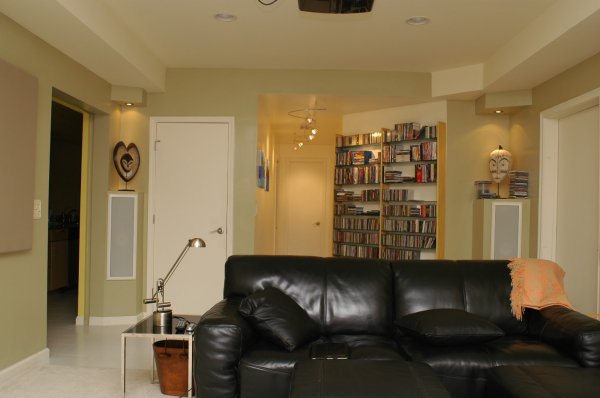
Does anyone have a recommendations for a particular type of heavy, sound absorbing drape. This might be the most practical approach for me.
Where are you thinking of putting the drapes?
Where are you thinking of putting the drapes?
In front of the open space in the back and the open space on the left on the pic.
In front of the open space in the back and the open space on the left on the pic.
What is outside that door on the left - a big open echoey space? And how far back behind the couch is that door you see center in the pic?
What is outside that door on the left - a big open echoey space? And how far back behind the couch is that door you see center in the pic?
Yes, very big, echoey space. The door in the back is about 12-15 feet behind the upening in the back wall.
He adviced against a full blown voicing session and suggest I make improvements to absorbtion in my room. Once this is done we can reconsider, but I got the impression he was quite confident I can get good results without his further professional help. I have a lot of open, echoing space behind my listening position (see pic). I need to find creative ways to absorb sound in this area - both in the open sliding door space and the hall in the back.
I fail to understand what was Jim opinion: "make improvements to absorption in my room" is something so vague that any one (even me) can suggest ... Wasn't Jim more specific? At what frequencies are you aiming - are you going to carry any measurements?
I fail to understand what was Jim opinion: "make improvements to absorption in my room" is something so vague that any one (even me) can suggest ...
True, but keep in mind I'm completely flying blind, and would not have a clue if I had too much or too little absorbtion to begin with .... Just to learn I had smearing of the sound because of reflections and echoing in the back of the room may be obvious to some, but it was not to me.
Wasn't Jim more specific? At what frequencies are you aiming - are you going to carry any measurements?
I already have measurements of my room (they don't look too shabby). Stay tuned - I will be getting more recommendations for improvement. Keep in mind that all Jim did was come in for a quick assessment (only doable when you happen to be local) and spend less than an hour in the room. This was NOT a full blown roomplay tuning session.
I fail to understand what was Jim opinion: "make improvements to absorption in my room" is something so vague that any one (even me) can suggest ... Wasn't Jim more specific? At what frequencies are you aiming - are you going to carry any measurements?
I'm not sure Jim uses decay time measurements? He would have to answer that.
For me something like an analysis of RT60 over octave bands, a waterfall or a spectrogram shows useful information into how sound is decaying at different frequencies and makes it easy to pinpoint issues.
I imagine from looking at your photos that Jim simply thought the room was too 'live' (i.e. in measurement terms the single figure RT60 was too high).
This measurement was a before (red) and after (black). The room had a lot of thin drapes that absorbed high frequencies above about 1k but did nothing below that. Subjectively the sound was lacking air and space. Remove the thin drapes, balanced the decay time, fixed the sound. Black magic...or just engineering?
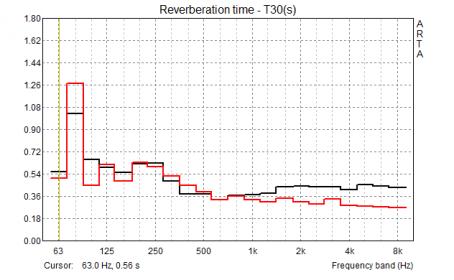
Last edited:
Yes, very big, echoey space. The door in the back is about 12-15 feet behind the upening in the back wall.
If you can hear the decay of the outside space from the listening room chair then you definitely need to block off the opening. Again, this type of behavior is easy to see on a RT60 by a secondary decay slope. For example these two measurements are from the same room, one with the door open, one with the door closed. The door led onto a big open plan hard surfaced foyer.
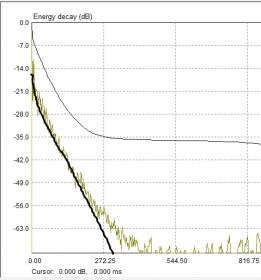
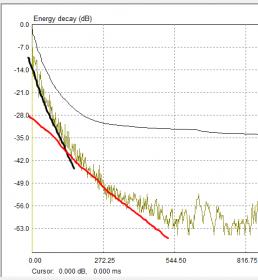
Notice the extended decay time of the second measurement and the dual slope nature to the energy decay.
If you can hear the decay of the outside space from the listening room chair then you definitely need to block off the opening. Again, this type of behavior is easy to see on a RT60 by a secondary decay slope. For example these two measurements are from the same room, one with the door open, one with the door closed. The door led onto a big open plan hard surfaced foyer.
Notice the extended decay time of the second measurement and the dual slope nature to the energy decay.
Nyal, Jim actually did whip out some measuring tools. Not sure what he measured. In any case, it appears I'm on the right track with the approach to close of the open spaces with dampening material. I am actually thinking of using drapes just in the open door. To absord the open space in the back I would construct a 96 x 48 4" thick panel (using corning 703) that can be folded up in the middle. The panel would be on swivel coaster wheels so I can move it around. What do you think?
This measurement was a before (red) and after (black). The room had a lot of thin drapes that absorbed high frequencies above about 1k but did nothing below that. Subjectively the sound was lacking air and space. Remove the thin drapes, balanced the decay time, fixed the sound. Black magic...or just engineering?
Nyal - just because you can use some measurements to help diagnosing gross faults in the room does not escape small room acoustics from the black magic attribute. It will help you tuning it, but anyone reading Jim pages will have no doubts - his best tools are his ears, his musical tracks and the laser space measuring and positioning tools. IMHO, no acoustic measurement will be able to carry or support the fine tuning he makes in the room.
Nyal - just because you can use some measurements to help diagnosing gross faults in the room does not escape small room acoustics from the black magic attribute. It will help you tuning it, but anyone reading Jim pages will have no doubts - his best tools are his ears, his musical tracks and the laser space measuring and positioning tools. IMHO, no acoustic measurement will be able to carry or support the fine tuning he makes in the room.
I agree with this observation. Jim used a real time analyzer (RTA?) in my room for bass frequencies only in determining the best listener position. The rest was done by ear with his select tracks and experience. Many hours later, he was satisfied, and I was thrilled with the improvement.
Nyal - just because you can use some measurements to help diagnosing gross faults in the room does not escape small room acoustics from the black magic attribute. It will help you tuning it, but anyone reading Jim pages will have no doubts - his best tools are his ears, his musical tracks and the laser space measuring and positioning tools. IMHO, no acoustic measurement will be able to carry or support the fine tuning he makes in the room.
Room acoustics is not black magic. Maybe to those who don't understand it. Sure it is complex and sure there are different ways of doing things but in general doing anything is better than doing nothing. And if you want to take a proven 'small room acoustical model' (live end dead end, non-environment, etc) then you can get those from huge body of work done for professional studios. The issue for two channel people is that most won't entertain or don't have the budget to really do what is required to fix their room acoustics.
I don't disagree with use of ears and music and listening to fine tune speaker placement. I do it myself when dialing in speaker separation, listener / speaker distance, toe in, rake etc and use laser levels, pointers etc as well. Maybe there is a way to do it using acoustic measurements but I haven't figured it out yet. Personally I don't think there is any black magic in speaker placement techniques, despite what everyone would have you believe. Jim is right on when he says first find the right position for the speakers / listeners for bass and then fine tune soundstage / imaging to suit.
Most rooms have gross errors in bass response that cannot be fixed by speaker / listener placement alone. Simple fact. And most have no idea also (sadly) what good, flat, resonance free bass sounds like.
Nyal, Jim actually did whip out some measuring tools. Not sure what he measured. In any case, it appears I'm on the right track with the approach to close of the open spaces with dampening material. I am actually thinking of using drapes just in the open door. To absord the open space in the back I would construct a 96 x 48 4" thick panel (using corning 703) that can be folded up in the middle. The panel would be on swivel coaster wheels so I can move it around. What do you think?
I think those changes will be worthwhile. You might also look at the RPG Variscreen which is basically a commercial version of what you say but with one side a diffusion (BAD) layer. For drapes use thick 16oz / sq yd or greater material, 100% fullness. Stage curtains basically. Rosebrand is a good source.
I would encourage you to look again at your room measurements holistically to see where they do and do not meet targets. Jeff and I put some targets out there a year ago in our Acoustic Measurement Standards white paper. Only then, once you have a total understanding of your room's deficiencies, would I take action. The issue with doing things in isolation is that you can waste time and money on intermediate solutions that don't solve some key problems or cause their own problems that you have to undo later. If you take a step back and look at the whole picture, work out the root causes of your issues then you can put together a much better roadmap of what changes to make to get your room where it should be.
I think those changes will be worthwhile. You might also look at the RPG Variscreen which is basically a commercial version of what you say but with one side a diffusion (BAD) layer. For drapes use thick 16oz / sq yd or greater material, 100% fullness. Stage curtains basically. Rosebrand is a good source.
I would encourage you to look again at your room measurements holistically to see where they do and do not meet targets. Jeff and I put some targets out there a year ago in our Acoustic Measurement Standards white paper. Only then, once you have a total understanding of your room's deficiencies, would I take action. The issue with doing things in isolation is that you can waste time and money on intermediate solutions that don't solve some key problems or cause their own problems that you have to undo later. If you take a step back and look at the whole picture, work out the root causes of your issues then you can put together a much better roadmap of what changes to make to get your room where it should be.
Thanks Nyal. The variscreen was precisely what I was planning to build, so I may just get,out the old checkbook and save myself some work instead...
Room acoustics is not black magic. Maybe to those who don't understand it. Sure it is complex and sure there are different ways of doing things but in general doing anything is better than doing nothing. And if you want to take a proven 'small room acoustical model' (live end dead end, non-environment, etc) then you can get those from huge body of work done for professional studios. The issue for two channel people is that most won't entertain or don't have the budget to really do what is required to fix their room acoustics.
I don't disagree with use of ears and music and listening to fine tune speaker placement. I do it myself when dialing in speaker separation, listener / speaker distance, toe in, rake etc and use laser levels, pointers etc as well. Maybe there is a way to do it using acoustic measurements but I haven't figured it out yet. Personally I don't think there is any black magic in speaker placement techniques, despite what everyone would have you believe. Jim is right on when he says first find the right position for the speakers / listeners for bass and then fine tune soundstage / imaging to suit.
Most rooms have gross errors in bass response that cannot be fixed by speaker / listener placement alone. Simple fact. And most have no idea also (sadly) what good, flat, resonance free bass sounds like.
Nyal,
Please do not take offense with the use of the words "black magic" to describe small room acoustics. The main idea that I want to express is that it is so complex and personal that most of the times you depend completely on the expertise of a single person. You can have a room and system with perfect frequency response and decays and lousy sound, and you can also have systems that measure miserably and sound great. I think you spotted an important point when you suggest that there is a minimum of resources and will that must be invested to fix room acoustics. In order to do it the fully scientific way the cost is enormous and few people are prepared to spend that amount, although a few firms can carry this type of projects.
Anyway, anyone reading your contributions to this forum and the links in this thread will understand that your approach and Jim's one to setting sound reproduction rooms and systems are quite different.
(...) Only then, once you have a total understanding of your room's deficiencies, would I take action. The issue with doing things in isolation is that you can waste time and money on intermediate solutions that don't solve some key problems or cause their own problems that you have to undo later. (...)
The best advice in the whole thread!
Staff online
-
treitz3Super Moderator
Members online
- sippy2
- Spirit Crusher
- defride
- gian60
- Mark212121
- agencal
- Geoffkait
- skids929
- facten
- bonzo75
- jbazz
- treitz3
- five
- jfrech
- Horns4life
- asdffx
- dennis h
- nattonrice
- strapper211
- banpuku
- JGlacken
- Juko
- AlbertD
- Thundersnow
- Crom
- shawnf
- geppo
- Corinthian
- dminches
- 3rdRock
- jaxdr
- sandervdp
- kimurastanley
- M27HF
- audiobomber
- kmyl
- tomas329
- Basile: Locrian Audio
- Ferris010
- DaveC
- hopkins
- audio.bill
- Inline Six
- Porsche
- Wjhen
- LarryK
- andromedaaudio
- jazzdude99
- Miramunt
- fbs
Total: 1,306 (members: 72, guests: 1,234)
| Steve Williams Site Founder | Site Owner | Administrator | Ron Resnick Site Co-Owner | Administrator | Julian (The Fixer) Website Build | Marketing Managersing |













